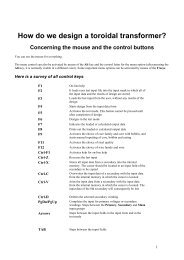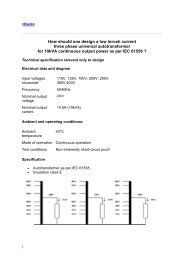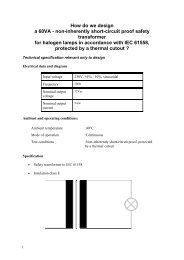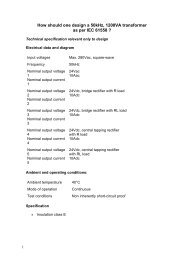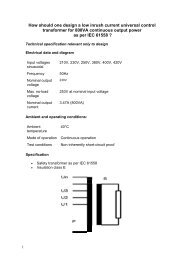Designing 100kHz, flyback transformers for input ... - Rale Engineering
Designing 100kHz, flyback transformers for input ... - Rale Engineering
Designing 100kHz, flyback transformers for input ... - Rale Engineering
You also want an ePaper? Increase the reach of your titles
YUMPU automatically turns print PDFs into web optimized ePapers that Google loves.
The duty cycle q is defined as follows:<br />
A <strong>flyback</strong> trans<strong>for</strong>mer with an automatic controller of output voltage and current ripple<br />
less than 100% is normally designed with the following parameters:<br />
"Nominal" <strong>input</strong> voltage Upnom= (Upmin*Upmax)1/2 = (125*700) 1/2= 296V. At this <strong>input</strong><br />
voltage the duty cycle qnom will be 0.5.<br />
This <strong>flyback</strong> trans<strong>for</strong>mer has to be designed at the <strong>input</strong> voltage Upmin = 125V. At this<br />
<strong>input</strong> voltage the duty cycle will be:<br />
qmax = Unom/(Umin + Unom) = 296/(125+296) = 0.7.<br />
Th duty cycle at the <strong>input</strong> voltage Upmax = 700V will be:<br />
qmin = Upnom/(Upmax+Upnom) = 296/(700+296) = 0.3<br />
Ripple of the <strong>input</strong> current at the minimal <strong>input</strong> voltage = 17%<br />
In order to have the ripple smaller than 100% at the maximal <strong>input</strong> voltage, you have to<br />
prescribe the ripple at the minimal <strong>input</strong> voltage as follows:<br />
Ripplemin = Ripplemax *(Upmin*qmax/Upmax/qmin)^2 = 100*(0.7*125/750/0.3)^2 < 17%<br />
5



